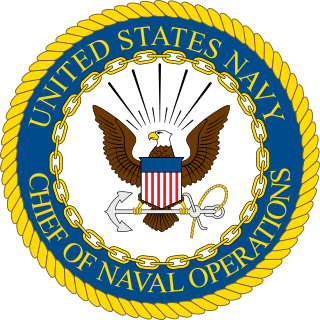
The chief of naval operations (CNO) is the highest-ranking officer of the United States Navy. The position is a statutory office held by an admiral who is a military adviser and deputy to the secretary of the Navy. The CNO is also a member of the Joint Chiefs of Staff and in this capacity, a military adviser to the National Security Council, the Homeland Security Council, the secretary of defense, and the president.

Chester William Nimitz was a fleet admiral in the United States Navy. He played a major role in the naval history of World War II as Commander in Chief, US Pacific Fleet, and Commander in Chief, Pacific Ocean Areas, commanding Allied air, land, and sea forces during World War II.

The Joint Chiefs of Staff (JCS) is the body of the most senior uniformed leaders within the United States Department of Defense, which advises the president of the United States, the secretary of defense, the Homeland Security Council and the National Security Council on military matters. The composition of the Joint Chiefs of Staff is defined by statute and consists of a chairman (CJCS), a vice chairman (VJCS), the chiefs of the Army, Marine Corps, Navy, Air Force, Space Force, and the chief of the National Guard Bureau. Each of the individual service chiefs, outside their JCS obligations, works directly under the secretaries of their respective military departments, e.g. the secretary of the Army, the secretary of the Navy, and the secretary of the Air Force.

The First Sea Lord, officially known as the First Sea Lord and Chief of Naval Staff (1SL/CNS) is a statutory position in the British Armed Forces, usually held by an admiral. As the highest-ranking officer to serve in the Royal Navy, the chief is the principal military advisor on matters pertaining to the navy and a deputy to the Secretary of State for Defence. In a separate capacity, the CNS is a member of the Chiefs of Staff Committee and, thereby, a military advisor to the National Security Council, the prime minister and the monarch. The First Sea Lord is typically the highest-ranking officer on active duty of the Royal Navy unless the Chief of the Defence Staff is a naval officer. Admiral Ben Key was appointed First Sea Lord in November 2021.
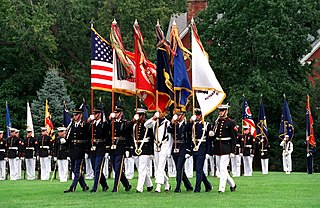
The several branches of the United States Armed Forces are represented by flags. Within the U.S. military, various flags fly on various occasions, and on various ships, bases, camps, and military academies.

Ernest Joseph King was a fleet admiral in the United States Navy who served as Commander in Chief, United States Fleet (COMINCH) and Chief of Naval Operations (CNO) during World War II. He was the U.S. Navy's second-most senior officer in World War II after Fleet Admiral William D. Leahy, who served as Chief of Staff to the Commander in Chief. He directed the United States Navy's operations, planning, and administration and was a member of the Joint Chiefs of Staff and Combined Chiefs of Staff.

William Daniel Leahy was an American naval officer. The most senior United States military officer on active duty during World War II, he held several titles and exercised considerable influence over foreign and military policy. As a fleet admiral, he was the first flag officer ever to hold a five-star rank in the U.S. Armed Forces.
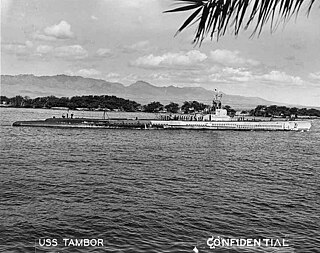
The Tambor-class submarine was a United States Navy submarine design, used primarily during World War II. They were the USN's first fully successful fleet submarine, and began the war close to the fighting. Six of the class were in Hawaiian waters or the Central Pacific on 7 December 1941, with Tautog at Pearl Harbor during the attack. They went on to see hard service; seven of the twelve boats in the class were sunk before the survivors were withdrawn from front-line service in early 1945; this was the highest percentage lost of any US submarine class. Tautog was credited with sinking 26 ships, the largest number of ships sunk by a US submarine in World War II. The Tambors attained the top speed of 21 knots (39 km/h) and range of 11,000 nautical miles (20,000 km) of the preceding Sargo class, and improvements included six bow torpedo tubes, a more reliable full diesel-electric propulsion plant, and improved combat efficiency with key personnel and equipment relocated to the conning tower. In some references, the Tambors are called the "T Class", and SS-206 through SS-211 are sometimes called the "Gar class".

The Sargo-class submarines were among the first United States submarines to be sent into action after the Japanese attack on Pearl Harbor, starting war patrols the day after the attack, having been deployed to the Philippines in late 1941. Similar to the previous Salmon class, they were built between 1937 and 1939. With a top speed of 21 knots, a range of 11,000 nautical miles (20,000 km), and a reliable propulsion plant, along with the Salmons they were an important step in the development of a true fleet submarine. In some references, the Salmons and Sargos are called the "New S Class", 1st and 2nd Groups.

Osami Nagano was a Marshal Admiral of the Imperial Japanese Navy and one of the leaders of Japan's military during most of the Second World War. In April 1941, he became Chief of the Imperial Japanese Navy General Staff. In this capacity, he served as the navy's commander-in-chief in the Asia-Pacific theater of World War II until his removal in February 1944. After the war, he was arrested by the International Military Tribunal for the Far East but died of natural causes in prison during the trial.
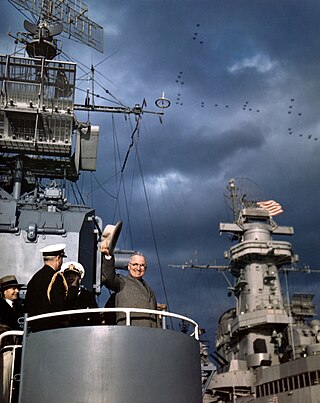
The "Revolt of the Admirals" was a policy and funding dispute within the United States government during the Cold War in 1949, involving a number of retired and active-duty United States Navy admirals. These included serving officers Admiral Louis E. Denfeld, Chief of Naval Operations, and Vice Admiral Gerald F. Bogan, as well as Fleet Admirals Chester Nimitz and William Halsey, senior officers during World War II.
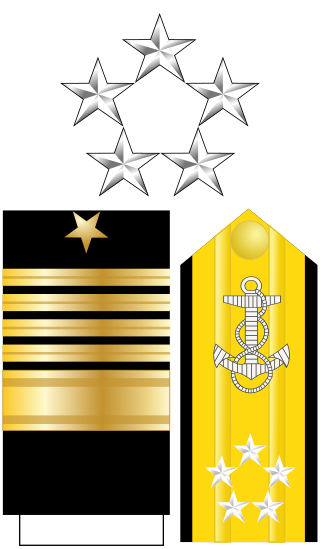
Fleet admiral is a five-star flag officer rank in the United States Navy whose rewards uniquely include active duty pay for life. Fleet admiral ranks immediately above admiral and is equivalent to General of the Army and General of the Air Force.

Joseph Mason "Bull" Reeves was an admiral in the United States Navy and an early and important supporter of U.S. Naval Aviation. Though a battleship officer during his early career, he became known as the "Father of Carrier Aviation" for his role in integrating aircraft carriers into the fleet as a major part of the Navy's attack capabilities.
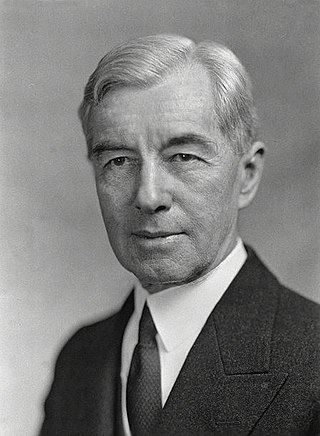
Thomas Charles Hart was an admiral in the United States Navy, whose service extended from the Spanish–American War through World War II. Following his retirement from the navy, he served briefly as a United States Senator from Connecticut.
The "bureau system" of the United States Navy was the Department of the Navy's material-support organization from 1842 through 1966. The bureau chiefs were largely autonomous, reporting directly to the Secretary of the Navy and managing their respective organizations without the influence of other bureaus. In 1966, the bureaus were gradually replaced by unified commands reporting to the Chief of Naval Operations.
Clarence Stewart Williams was a four-star admiral in the United States Navy who served as commander-in-chief of the United States Asiatic Fleet from 1925 to 1927.

Admiral Samuel Murray Robinson was a United States Navy four-star admiral who directed Navy procurement during World War II.

James Lemuel Holloway Jr. was a four-star admiral in the United States Navy who served as superintendent of the United States Naval Academy from 1947 to 1950; as Chief of Naval Personnel from 1953 to 1957; and as commander in chief of all United States naval forces in the eastern Atlantic and Mediterranean from 1957 to 1959, in which capacity he commanded the 1958 American intervention in Lebanon. As founder of the Holloway Plan, he was responsible for creating the modern Naval Reserve Officer Training Corps.

Rear Admiral Reginald Rowan Belknap was an officer in the United States Navy. He served in the Spanish–American War, Boxer Rebellion, Philippine–American War, and World War I. He gained distinction in 1909 for his relief work in Italy after the 1908 Messina earthquake and tsunami and for his work in command of the first offensive mining campaign in U.S. Navy history, the laying of the North Sea Mine Barrage in 1918. He was also a published author, an inventor, a member of many professional and social organizations, and an active member of the Episcopal Church, and he played a role in the selection of Amelia Earhart as the first female pilot to make a solo flight across the Atlantic Ocean.
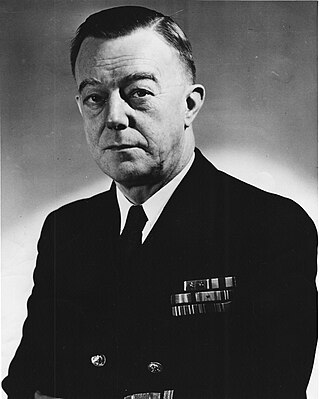
Rear Admiral Thorvald A. Solberg was a senior officer in the United States Navy, and the Chief of the Office of Naval Research from 1948 to 1951.


















